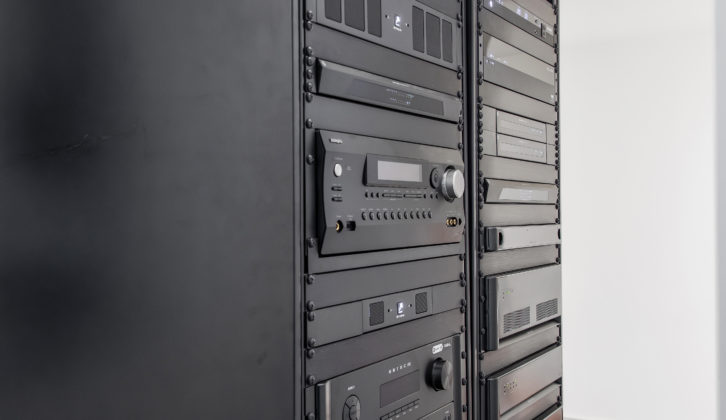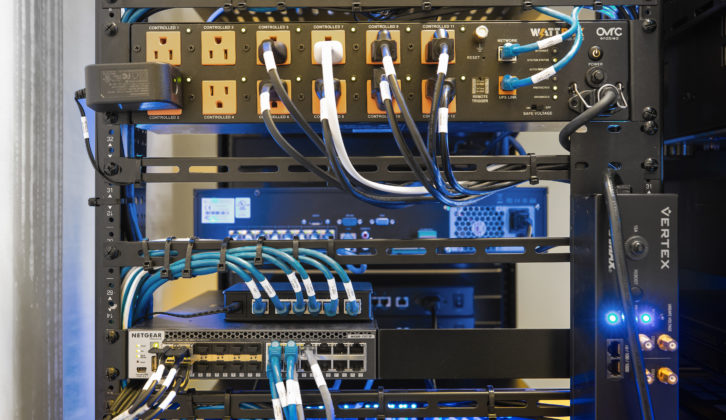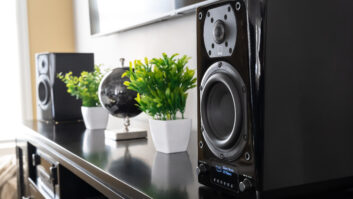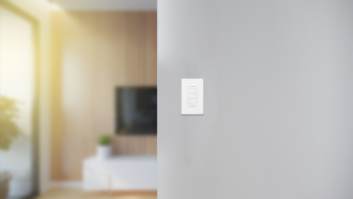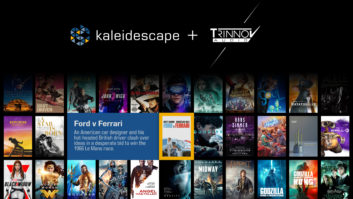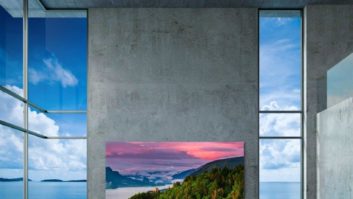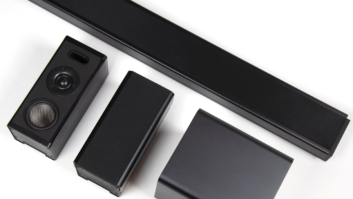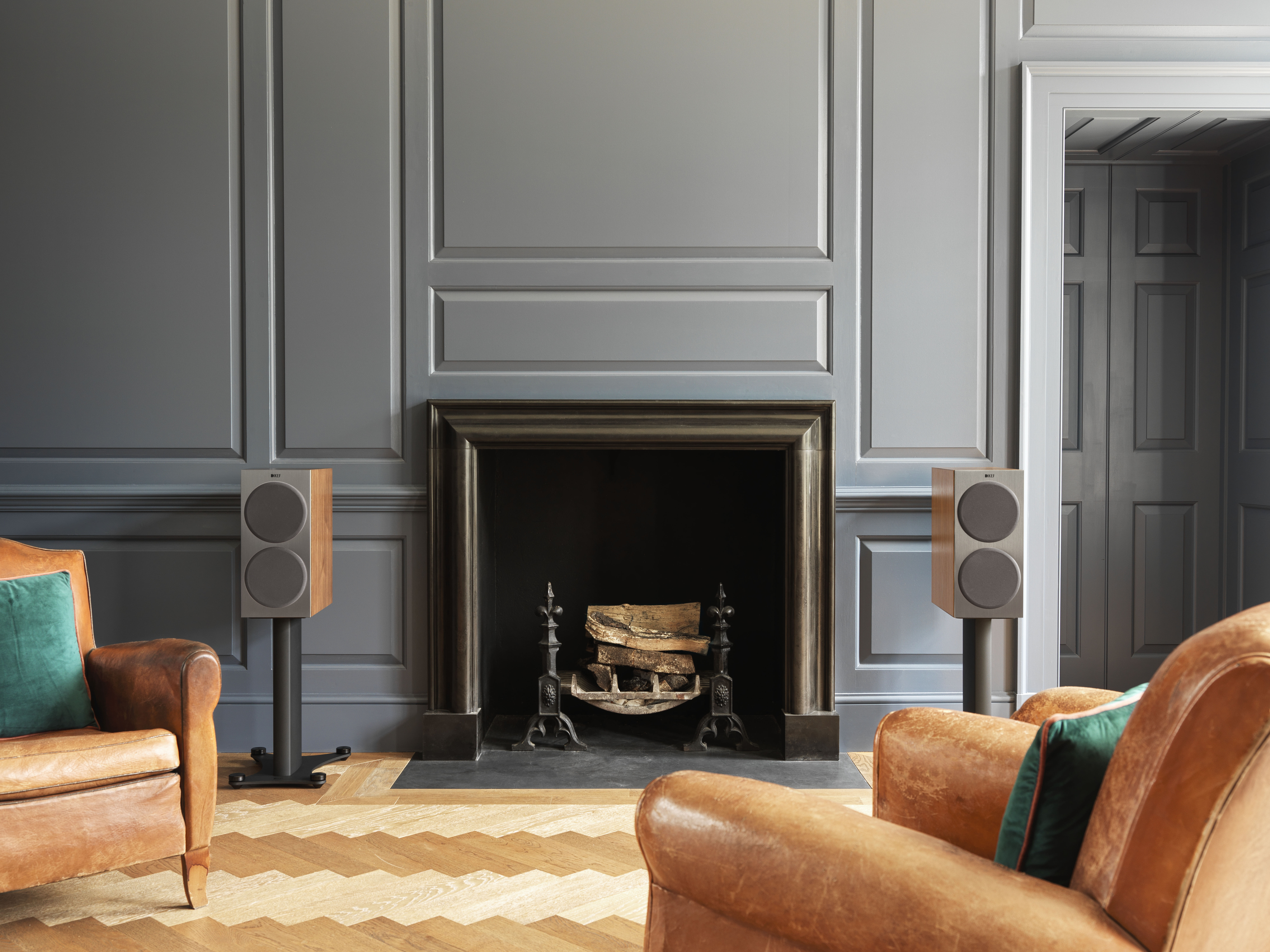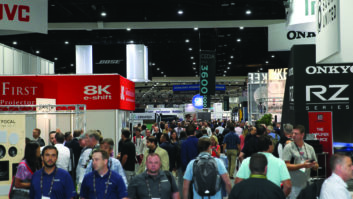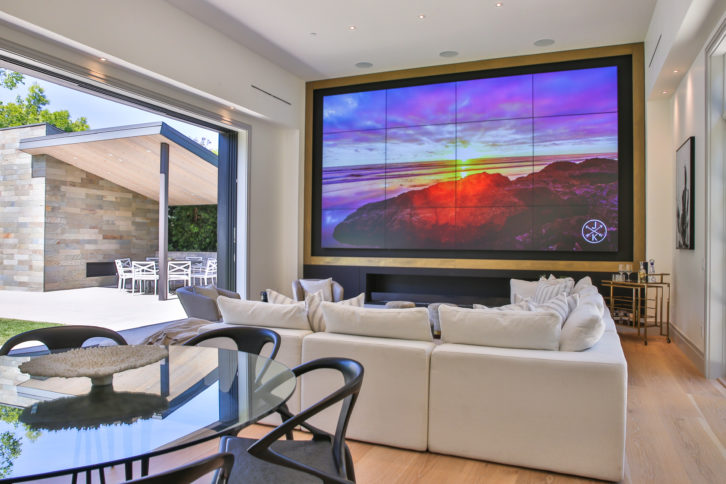
It all started with a wall; an enormous white behemoth of a surface that laid its claim to a main gathering hub of the home for both family and guests.
The home was a brand-new construction in Pacific Palisades, CA, and it was built to be the best. It was one of the only homes in that area to have a basement, which had to be carved out of solid bedrock. It would grow from that foundation to a grand 11,607-square-foot, boomerang-shaped structure that holds seven bedrooms, 10 bathrooms, a spa, library, office, a home theater, and wine rooms next to a yard that features a pool and a cabana.
But let’s get back to that wall. “The client was looking at pricing for 85-inch, 98-inch, and 100-inch screens, and even the 100 didn’t cut it,” says Patrick Coleman, owner, Future Automation & Design, Redondo Beach, CA. “And the room has these massive Fleetwood doors on either side with so much natural sunlight that comes through, so he didn’t want to do a projector. Although I did suggest that we use the Screen Innovations’ Zero-G dropdown, motorized screen that is on tension cables, but he wasn’t interested in that because he didn’t want to have a projector with a loud fan in the room.”
Residential Systems is now on LinkedIn! Click here to follow us for business and technology insights!
The hunt was on for a solution. At the time, the client was living in London, and when he came to town, Coleman would take him around to Future Automation’s clients’ homes and show what he did for them, and explain how it could be applied to the new space. “We grew a great rapport with the client and his wife,” says Coleman. “At Future Automation & Design, we like to do what we call ‘home tours,’ where we will demonstrate some of the larger projects we have done because no showroom out there is as big as some of the projects that we work on. I act like a limousine driver and I treat them like royalty as I drive them around to several locations throughout L.A. County.”
Future does large projects for prominent people, and it is telling of his clients’ appreciation for his work that they will let him bring new customers to their spaces. “We ask our clients if they are okay with home tours,” says Coleman. “There’re a few key clients that we want to show off. And this new client fell in love with the video wall we showed him at a project that we did in Century City.”
That project involved a condominium where the client originally wanted an enormous fish tank to go along the wall, but when neighbors balked, he had to re-think his strategy. “No one wants to deal with a saltwater tank that could leak into other units nearby,” says Coleman. “I suggested a video wall that’s running 24/7 in the background and we can have it play underwater ocean photography and videography.”
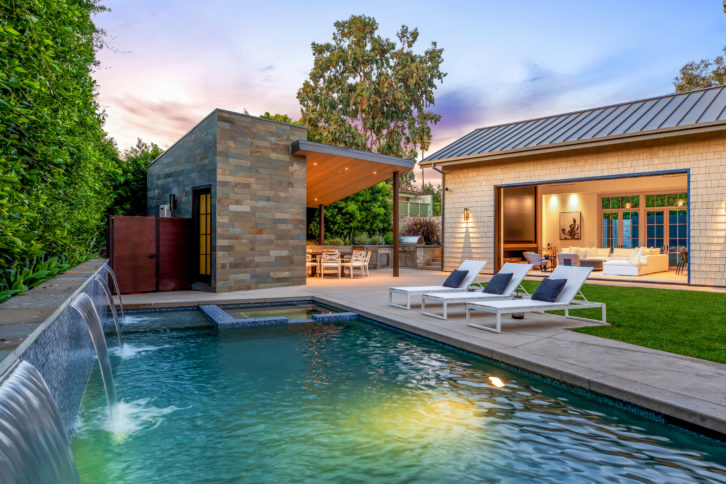
That video wall installation turned out so well that Coleman added it to his home tours, making a deep impression on his Pacific Palisades client, who decided that it was the answer to his big wall problem.
Future Automation & Design created a video wall for him made up of 16 55-inch Planar Clarity Matrix G3 LCD panels — adding up to a massive 25-foot image. Sound is provided through Sonance architectural speakers placed in the ceiling as well as Sonance subwoofers, which required some assistance from the two architects on the project.
“The architects made a very cool framing system around the video wall,” says Coleman. “We have two 12-inch Sonance subwoofers being powered by 1000 watts each in that wall, and you would never know where they are because we created an acoustic chamber for them to travel through all the way to the fabric on the front of the wall. There was a lot of engineering, and it was a lot of fun, but it was a lot of work.”
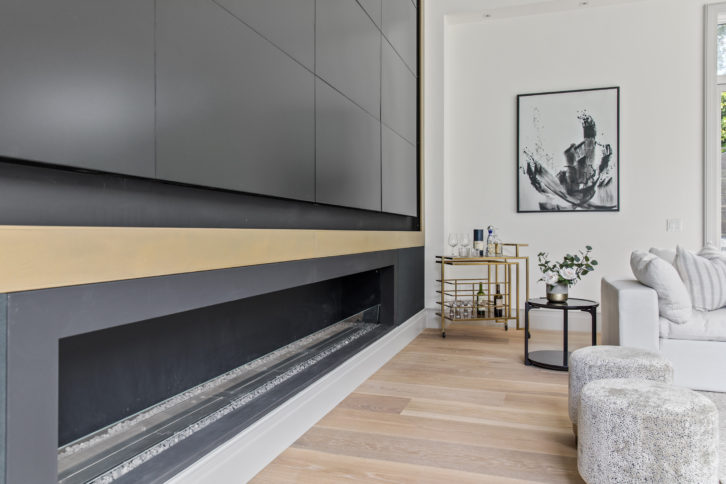
The video wall is included in the home’s Savant system, which was partially chosen as the home’s automation system because it can handle video tiling. “Right now, we’re demoing it with two video sources,” says Coleman. “So we can do a picture-in-picture effect; we can slide into the corners, make one larger and one smaller, and so on. It’s all done just using the iPad or the touch screen to move it around, which the customers love. It’s so simple to use.
“With the Savant system, you can take those 16 panels, and, because we’re using the state-of-the-art 10 gigabit video distribution system from Savant, we could have as many sources as they want. They could have 16 different sources play on that video wall right now, if they want to.”
Also by Anthony Savona: The Surprise Home Theater
This home build took three and a half years, and, at the time Coleman was spec’ing it out, the Planar video wall made the most sense from both technological and economical senses. “Our video wall came in at around $175,000, not including installation, but the actual parts. That is a big value proposition because the bezels are extremely thin. I know that it’s a luxury property in our world of outrageously expensive electronics, but it’s a really good value to be able to offer a brand like Planar, because not everybody’s going to spec in a million-dollar wall with no bezels. First of all, it didn’t exist for residential when we were doing it, but even now, with the LG OLED wallpaper and the Samsung Wall, it’s an expensive proposition. If you wanted to do a Sony Crystal LED system right now, you are talking a million dollars by itself for a wall that size.”
The Second Big Screen
When asked which parts of the home technology installation are his favorites, Coleman acknowledges the video wall, but adds that is it is in a tie with the home theatre Future installed in that unique-to-L.A. basement.
“Unlike upstairs, the whole room is acoustically treated,” he says. “You can feel your chest shake during action scenes in a movie. We are using a dialed-in and calibrated Sony laser projector that looks phenomenal with the Stewart Filmscreen Studiotek screen. The sound is phenomenal. It’s all in a controlled environment with absolutely no light coming in whatsoever.
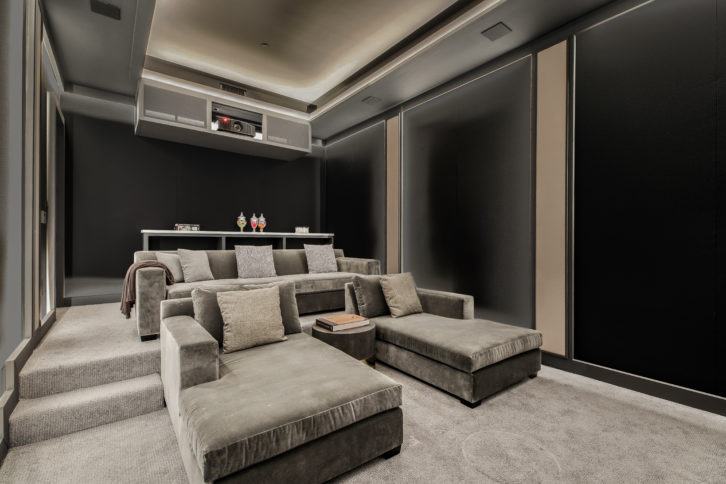
“We are just short of IMAX specification on the screen because we are wall-to-wall, but we’re a few inches shy of floor-to-ceiling. The room has custom LED lighting throughout, and it’s got a Pro Audio Technology custom speaker system with Dolby Atmos. We have three racks total in the house — one for the video wall upstairs and two larger racks in the basement. It is a really beautiful space.”
It seems everywhere you look, there is spectacle to be seen. “We have an integrated pool control system of lighting throughout the property,” says Coleman. “There’s a Butler’s kitchen, a secondary pantry, and main kitchen; there are amazing lighting fixtures that look like jellyfish, and there’re these pylons that, that come out of the concrete on the front of the driveway — like you see at embassies.”
Also by Anthony Savona: Bridging the Gap Between Design and Tech
A Surprising Twist
As the three-and-a-half-year journey of the house was nearing completion, the owner decided to sell it, as he wound up relocating to a different state (where Coleman continues to work remotely with him on this even-newer abode). The house is currently on the market with a number of interested parties checking it out.
For Coleman, this means he has to wait a bit longer to finish the job, including wiring the driveway pylons into the Savant automation system and fitting the home for shades. “The windows are just begging for motorized shading,” he says. “We sell motorized shades from Screen Innovations and QMotion, so I recommended we put up shades to the original owner, but he said, ‘No, I don’t want to spend that right now because we’re trying to sell the house. We’ll let the, let the new owners decide on that.’
“So we prepped for it, but didn’t go any further. We have iPort metal brackets with iPads in them, and there’s custom backlit buttons that are on there, but not all of them are programmed because several of them are reserved for motorized shades.”
Of course, there is no guarantee that the new owners will want to work with Future Automation & Design, but it would seem to be the smart move. “I engineered every square inch of that place,” says Coleman. “We’ve got the Savant home automation, 10 gig distributed video throughout the house, distributed high-resolution audio with speakers throughout, built in subwoofers, and an incredible outdoor system. We have pre-wired the entire home as well for expansion — we ran somewhere in the range of 40 miles of wire throughout this house!”
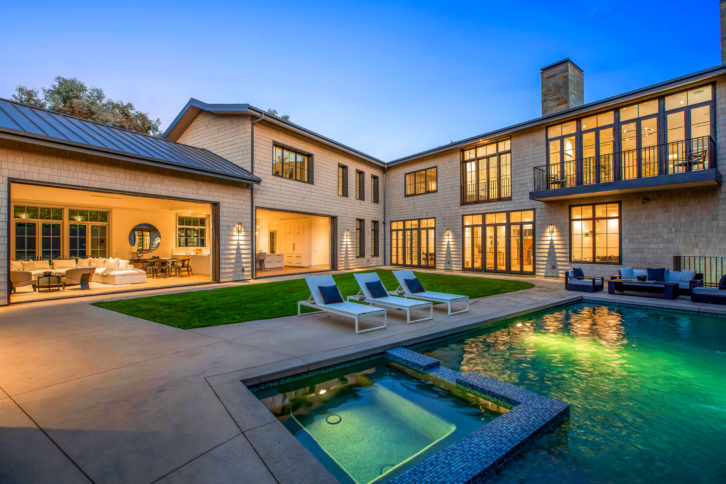
In addition to his company’s technical knowledge of the home, Coleman believes there are other reasons why the new homeowners should bring him on to finish the job. “They’re a lot of luxury integrators in Los Angeles,” he says, “but I really do feel like a lot of them don’t have that personal touch that we do. I’m not in it just for the business, but for the passion of it. And I want my clients to be passionate about what we do and get excited.
“We don’t do a project, finish it, and then we’re done and walk away. We treat our clients like family members, and they always remind us and tell us they can’t get this kind of service anywhere else.”
Follow Future Automation & Design on Instagram at @FutureAutomationDesign.
